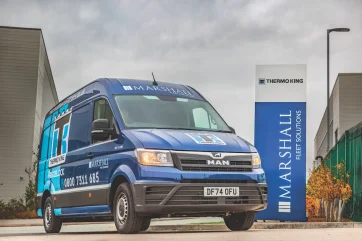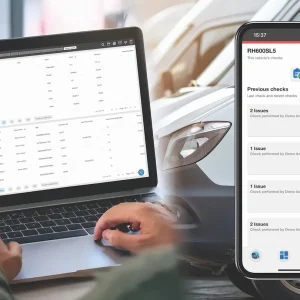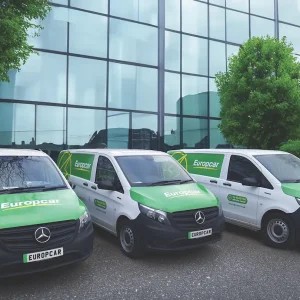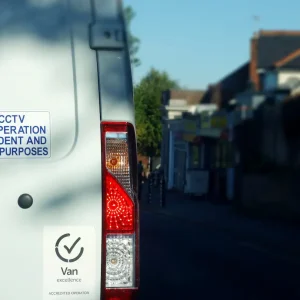
Anybody tempted to dismiss MAN’s TGE Next Level, launched last year, as simply a carbon copy of Volkswagen’s Crafter, from which it is derived, might want to think again.
The manufacturer is making full use of a site it has set up in Poland, not far from the TGE/Crafter assembly plant, under the MAN Individual banner. The specialist operation is boosting the workhorse’s appeal with a host of cosmetic enhancements.
If you want fancy sill guards, stainless steel trim at the front, black alloy wheels, red brake callipers and a three-piece roof spoiler among lots of other goodies, then you can have them. Interior embellishments include leather-trimmed seats with red stitching and embroidery that incorporates MAN’s lion logo.
The company is marketing a complete package of extras under the Individual Lion S banner calculated to appeal to small business owners and the self-employed who want a van that really stands out in the high street.
What is more, MAN Individual has come up with a tuned 202hp version of the TGE’s 2.0-litre TDI diesel that delivers 25hp more than the most-powerful 177hp standard 2.0-litre TDI. Torque stays the same, however.
All TGE Next Levels boast a host of new and revised driver assistance systems, many of which are fitted as standard. Also fitted are a redesigned dashboard with digital instrumentation and a large touchscreen, keyless ignition and an electronic parking brake.
As well as the two engine options referred to above, customers can pick from either a 140hp or a 163hp TDI. They can also select either a six-speed manual or an eight-speed automatic transmission.
Sales target
MAN sold 3,200 TGEs in Britain last year, says UK van sales director Toni Ward, 50% of which were Next Level models. The company aims to boost registrations by roughly 20% this year.
Recent customers include Thermo King and Frigoblock refrigeration unit distributor Marshall Fleet Solutions, which has taken 59 for its customer service fleet, and hydraulic systems repair specialist UK Hose, which has taken a dozen. They are being used by its team of mobile engineers.
Both businesses have acquired standard-wheelbase front-wheel-drive 3.5-tonne vans, with Marshall opting for the 140hp diesel, and UK Hose selecting its 177hp stable-mate. TGE is up for grabs with rear-wheel-drive too, and in 4×4 guise.
MAN started selling the TGE in Britain in 2017, initially to customers who already operated the manufacturer’s trucks. Today it is casting the net much wider, targeting firms that do not operate heavy goods vehicles, and may never have run MANs before, as well as consolidating its existing client base.
“We’ve set up a retail sales team that deals with customers that run from one to 25 vans, a team of regional fleet executives that look after companies with from 25 to 250 vans, and a key account team that deals with really major clients; the blue light fleets, for example,” Ward says.
The majority of the salespeople are employed directly by MAN rather than by dealers.
So why buy a TGE rather than a Crafter or, say, a Ford Transit or a Peugeot Boxer? “Because of the aftersales support our dealers can provide,” she replies.
TGE is sold through MAN truck dealers who open their workshops round-the-clock because that is what hauliers expect. “As a consequence, a TGE owner can drop their van off at 6pm, get it serviced overnight and pick it up at 6am ready to go to work,” she says.
That gives MAN the edge over van makers that are primarily represented by car dealers who are not open 24/7, she contends. It will also make it easier for the marque to fend off the challenge posed by some of the newer Chinese brands appearing in the UK, she adds.
“They don’t have dealer networks, so how will they support their customers?” she wonders. “By contrast, we’ve got 62 locations.”
It should of course be noted that Maxus, a Chinese brand, now has a well-established network that includes some prominent commercial vehicle dealerships, but it took several years to set it up.
With load cubes going up to 18.4m3, vans make up 80% of TGE sales in Britain, with chassis cabs, chassis crew-cabs, and chassis cowls accounting for the remainder. MAN has built up strong links with body-builders such as CoolKit, says Ward, with a 35-strong Professional Partner network that can provide everything from van load area ply-lining to loader cranes.
The interest the Individual versions of TGE could generate may help to divert attention away from a yawning gap in the Next Level line-up. An electric version – the eTGE – will not appear until late 2027, when production will start, which means it is unlikely to arrive on this side of the channel until 2028.
Details are sketchy at present, but the range between recharges is likely to be over 250 miles, says Ward. “We know we’ll be later into the market than our competitors but we want the vehicle to be right, with the right range and the right payload,” she explains.
Legislation concern?
In the meantime MAN risks being hammered by the UK government’s ZEV (Zero Emission Vehicle) mandate, which imposes substantial fines on van manufacturers who fail to meet its electric new van sales target. It is set at 16% this year, up from 10% in 2024, and will rise in incremental steps to 100% by 2035.
This policy may of course be revised, especially in the light of recent global economic events. As things stood at the time of writing, however, light commercial manufacturers that breached the target face a massive fine of £15,000 for every non-compliant diesel or petrol van sold.
Given that fines can be applied to any manufacturer that sells more than 2,499 light commercials in the UK annually, that suggests MAN could soon be obliged to write a rather large cheque. However, things are not quite so simple, says Ward.
For a start ambulances are not included, she points out, and MAN has been supplying a growing number of late. That includes an order for 300 destined for the East of England NHS Trust Ambulance Service.
TGE-based motorhomes are excluded too, and a lot depends on how the vehicles are homologated by the factory.
If the engine is homologated as a truck engine, then it does not count towards the ZEV target.
There is also the point that roughly 5% of the TGEs sold in Britain gross at either five or 5.5 tonnes rather than 3.5 tonnes, and are not classed as light commercials.
To date, this approach has ensured that MAN has not been clobbered by ZEV penalties, but it must surely inhibit its ability to grow to the extent that it would wish to. It seems unlikely to be able to realise its full potential until the eTGE arrives, but at least it has laid the foundations ready to forge ahead when that happy day dawns.
Renault Trucks dealers now sell the Renault Trafic as well as the Master. So what are the chances of MAN dealers selling a rebadged VW Transporter – a Trafic rival – given the close ties between MAN and VW?
The opportunity hasn’t materialised, says Ward – but there’s little doubt that she’d welcome it if it did.





